The Snapdragon 845 Performance Preview: Setting the Stage for Flagship Android 2018
by Ryan Smith & Andrei Frumusanu on February 12, 2018 12:30 AM EST- Posted in
- Mobile
- Snapdragon
- Qualcomm
- Smartphones
- SoCs
- Snapdragon 845
System Performance
To see how the new CPUs and memory subsystem translate into more real system performance, we move onto more representative tests such as PCMark. PCMark’s performance is affected by several factors: not only does raw performance of the hardware count but also we need to consider the individual system’s software stack. We’ve seen large differences between Android OS major versions where the improvements of the Android Runtime can be directly visible in subtests such as the Writing test. Also a SoC’s DVFS schemes and schedulers can have huge impacts on “performance-latency”, meaning how fast the CPUs can ramp up a workload. This directly translates in a lot more performance in several of PCMark’s subtests as in the default settings none of the tests actually represent the pure performance of the CPU if it were locked at maximum frequency on the performance cores. The results of the tests are also overall a good representation of “snappiness” of a device.
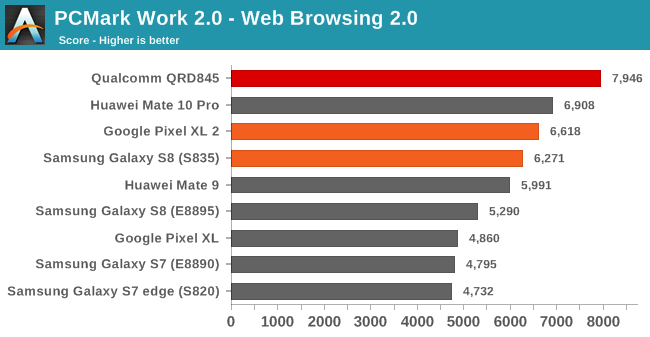
In the web browsing test the Snapdragon 845 QRD manages to outpace the Pixel 2 XL by 20%. Here we’re also looking at performance across devices with different OS versions. The Google devices are running Android 8.1 while the Samsung devices were tested with Android 7.0. The Mate 10 Pro runs Android 8.0 while the Mate 9 still had 7.0. The Qualcomm QRD we tested ran Android 8.0.
Again the performance increase over Snapdragon 835 devices isn’t all that great. DynamiQ allows for far more efficient thread transitions between the CPU cores and subsequently I expected Qualcomm to take advantage of this through more aggressive scheduling resulting in more than just a 20% increase. The difference between the Mate 9 and Mate 10 here is a good example of what a software configuration change can bring in terms of performance (both devices employ same performance CPU configurations). Samsung’s Exynos’ SoCs still use GTS scheduling and have non-optimal performance-latency resulting in bad scores, amplified by the fact that Samsung’s memory performance is also underwhelming when compared to the Snapdragon and Kirin SoCs.

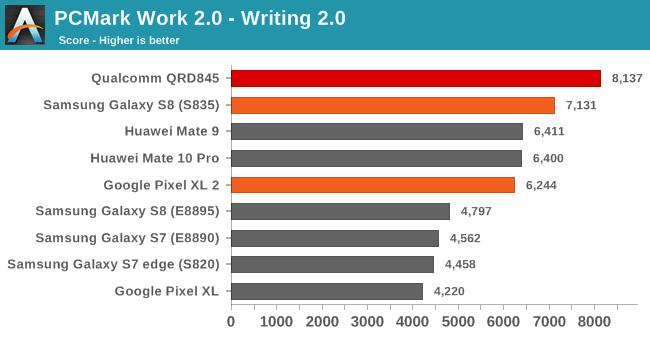
The Data Manipulation and Writing 2.0 tests make heavy use of the Android runtime and APIs and also a very memory latency sensitive. Between the best showings of the Snapdragon 835 variant of the S8 and the Pixel 2 XL in each respective benchmark, the Snapdragon QRD845 showed conservative increases of 8 to 14%. The Exynos SoCs lacklustre performance is again hampered by software and by bad memory performance.
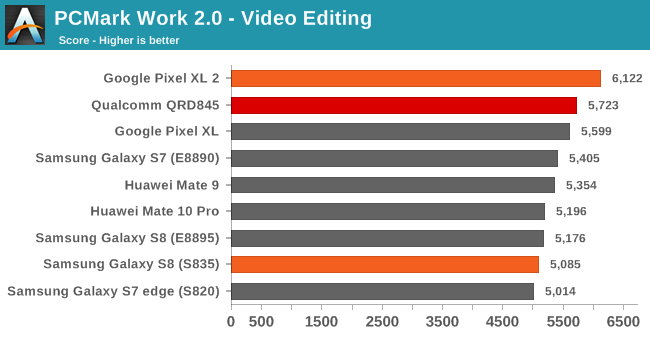
The video editing test is PCMark’s weak-point as it’s bottlenecked by things such as OS API overhead, and why we see tight grouping of performance results across a large range of SoCs. The Snapdragon 845 ends up high, but below the Pixel 2 XL. I would not put much weight on the results of this test as they’re not necessarily representative. Futuremark claims that the test is a lot more sensitive in mid- and low-range devices which can exhibit performance issues.
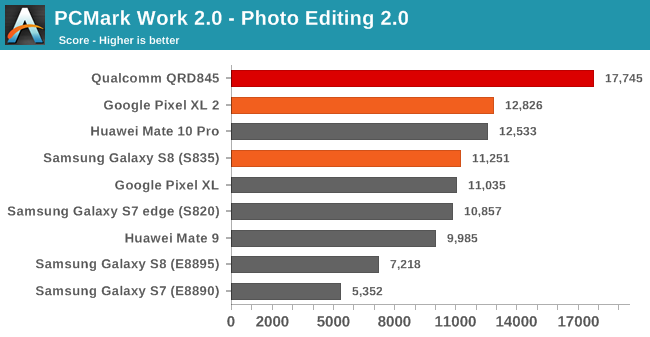
The photo editing test makes heavy use of Renderscript and use GPU acceleration to apply various effects on an image set. The QRD845 here shines as it’s able to showcase a 38% performance improvement over the Pixel 2 XL. Again the test not solely tests the raw performance of the system but also how optimized it is in terms of the software stack. This can be seen in the Kirin vs Exynos devices as Huawei’s phones vastly outperform Samsung’s devices in this test.
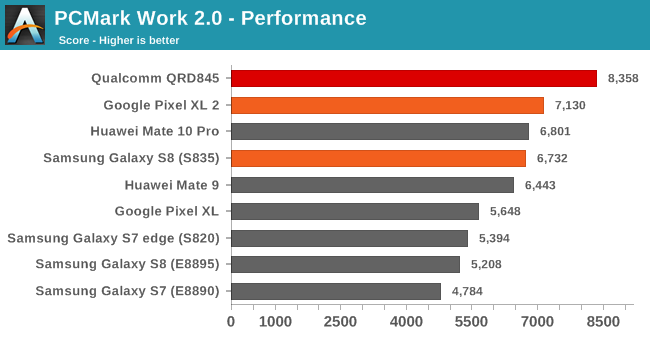
Overall PCMark’s performance score for the QRD845 increases by 17% over the Pixel 2 XL. Disregarding the video test, we see a similar scenario as in the synthetic tests as the new SoC’s CPU performance increases are lower than we had expected. Still the Snapdragon 845 is able to top the charts and should adequately power 2018’s flagship devices.
For 2018 we are reviewing our mobile benchmarking suite and altering some of the benchmarks we use. One of the changes in the way we benchmark devices is that we’re moving away from standalone browser and rather are benchmarking the OS’s WebView implementations. In general this seems to be a better choice for testing device experience as there is a lot of content that is being consumed via WebView windows. We also avoid the argument about different browser performance and since Google has now made WebView an updatable Play Store component we should also have valid comparisons older devices and systems. On the iOS side we do the same as we now benchmark browser tests within a WkWebView shell.
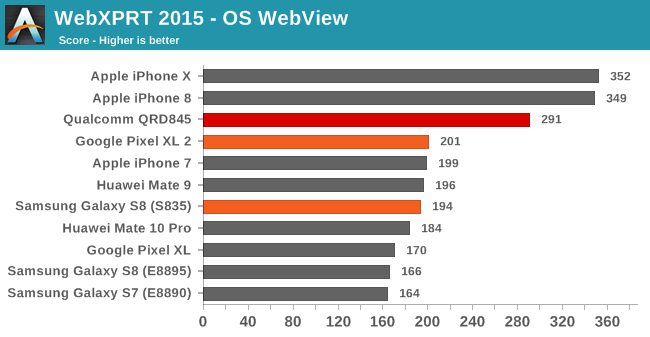
Starting off with WebXPRT 2015 for a last time before we’ll retire it in favour of WebXPRT 3, we see the QRD845 performing fantastically. Here the 44% performance increase over the Pixel 2 XL is a lot more in line with what we had expected of the new SoC. The QRD845 is even able to catch up a lot with Apple’s newest A11 and Monsoon cores in this test.
To keep up with the ever changing landscape of the developing web, we’re also retiring past JavaScript benchmarks in favour of a brand new and more representative benchmark developed by the WebKit team and welcomed by Google; Speedometer 2.0.

Here the Snapdragon 845 showcased another healthy performance increase of 37% over the Snapdragon 835 devices. Apple’s superior JavaScript performance can be attributed to a much faster and more optimized Nitro engine while Google’s V8 has only seen meagre improvements over the years. Notable is the Apple A11’s massive performance jump over the A10 – vastly increasing the distance to Android devices.










140 Comments
View All Comments
id4andrei - Monday, February 12, 2018 - link
Andrei, what can you and the staff at Anandtech do to prevent stuff like Apple's permanent throttling from flying under the radar? I mean a new device throttles temporarily but the iphone 7 was found(by Geekbench) to have been already "permanently" throttled after one year.Also, could Apple dropping Dialog - maker of power management chips - have something to do with this?
Dr. Swag - Monday, February 12, 2018 - link
Why have none of the soc makers besides Qualcomm and apple used anything other than Mali gpus? It's obvious that Mali is lacking in perf/watt so why not use something from, say, imagination that seems to have much better perf/wattfrenchy_2001 - Monday, February 12, 2018 - link
Because integrating a different solution (like powerVR) or even designing your own (like Adreno) requires more efforts (and hence money).ARM offers a full turn-key solution.
Like their CPU cores, their GPU cores are not the best, but for most of the industry, they are good enough.
This lack of valuation of the graphic component is partly why nvidia left the phone chipset market. Few care enough to pay (in effort, silicon space or licensing) for good graphics.
(Apple and Qualcomm obvious exception, with their own designs)
warrenk81 - Monday, February 12, 2018 - link
Any update on reviews for 2017 flagship devices? iPhones, Pixels, iPads? anything? i realize it's not a trivial undertaking to review those, but something other than announcements and press releases would be nice.Wardrive86 - Monday, February 12, 2018 - link
Great article! SD845 performance seems to be right where it was expected to be. I am glad for that. It looks like even the midrange QC SoCs will be using a mix of 385 gold and silver cores at wildly varying clock speeds , various levels of "system cache" and Adreno 6xx series gpus. I think this year is going to be great from the high to the low end. Thanks for confirming that "system cache" acts like an L4. I hate to see DRAM latency has went up but from a memory perspective these new devices are completely different than what were used toYaldabaoth - Monday, February 12, 2018 - link
So... maybe a Snapdragon 845 Netbook-style Windows S device won't suck as bad (or at least won't be as graphically laggy) when paired with suitable other components? Maybe?lucam - Monday, February 12, 2018 - link
I take this article as you have officially tested the iPhone X? :) At long last...Raqia - Monday, February 12, 2018 - link
It's interesting that they chose the lower sized 256k L2 cache per core configuration instead of going for 512k per core. Perhaps it's die space, or something to do with hitting a sweet spot in simulations against their own custom memory bus and L4 cache.yhselp - Tuesday, February 13, 2018 - link
By my utterly amateurish calculations, the S845 is the first Android SoC nearing the single-threaded performance of Apple's A9. Can't wait to see what the Exynos 9810 has to offer.Krispytech - Tuesday, February 13, 2018 - link
Geekbench scores are out for the Exynos S9 3700 single core much faster than the 845.